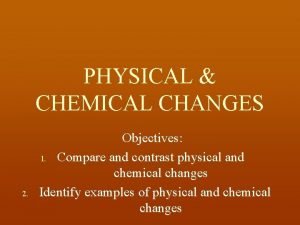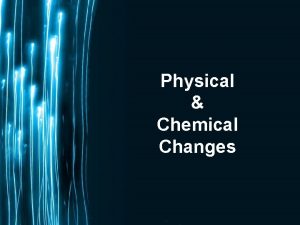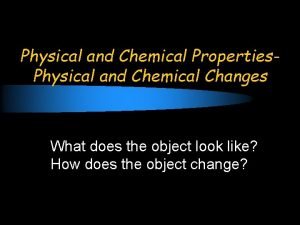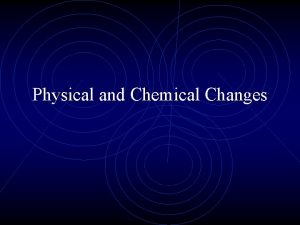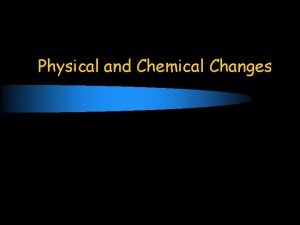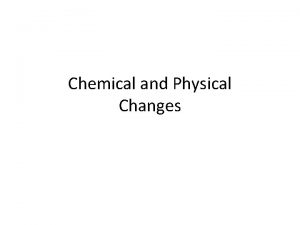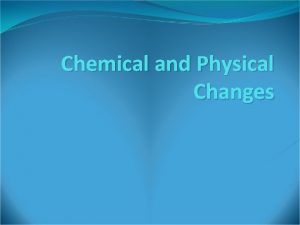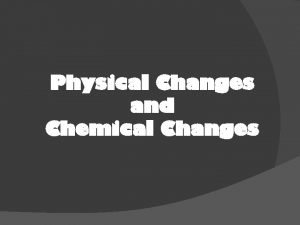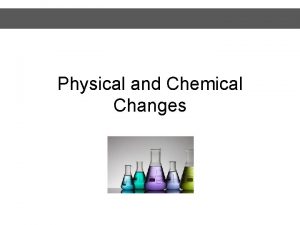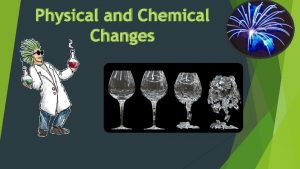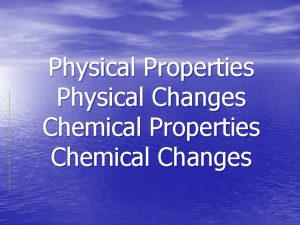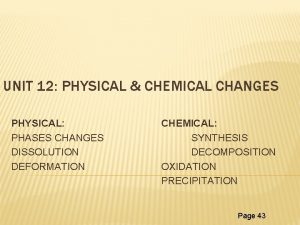Unit 1 Lesson 3 Physical and Chemical Changes











- Slides: 11

Unit 1 Lesson 3 Physical and Chemical Changes Copyright © Houghton Mifflin Harcourt Publishing Company

Unit 1 Lesson 3 Physical and Chemical Changes Change of Appearance What are physical changes of matter? • A physical change is a change that affects one or more physical properties of a substance. • The appearance, shape, or size of a substance may be altered during a physical change. • Physical changes, such as changes in state, do not change the chemical identity of a substance. Copyright © Houghton Mifflin Harcourt Publishing Company

Unit 1 Lesson 3 Physical and Chemical Changes Change from the Inside What are chemical changes of matter? • A chemical change is the process by which one or more substances change into entirely new substances. • Chemical changes are not the same as chemical properties. • Burning is a chemical change; flammability is a chemical property. Copyright © Houghton Mifflin Harcourt Publishing Company

Unit 1 Lesson 3 Physical and Chemical Changes What are chemical changes of matter? • When the particles and chemical bonds that make up a substance are rearranged, a chemical change has taken place. • Chemical changes are often influenced by temperature. • Higher temperatures often mean faster chemical reactions. Copyright © Houghton Mifflin Harcourt Publishing Company

Unit 1 Lesson 3 Physical and Chemical Changes Look for the Signs How can you tell a chemical change has happened? • There are several signs that a chemical reaction has occurred. • Observing two or more of these signs during a change means you are likely observing a chemical change. Copyright © Houghton Mifflin Harcourt Publishing Company

Unit 1 Lesson 3 Physical and Chemical Changes How can you tell a chemical change has happened? • Odors can be produced during a chemical change. • Fizzing and foaming may mean gases are being produced. • The production of gas is often evidence of a chemical change. • Boiling also can produce gas bubbles, but boiling is a physical change. Copyright © Houghton Mifflin Harcourt Publishing Company

Unit 1 Lesson 3 Physical and Chemical Changes How can you tell a chemical change has happened? • A precipitate is a solid that falls out of solution. • The formation of a precipitate can indicate a chemical change. • Energy that changes from one form to another can be evidence of a chemical change. • Changes in temperature and color can be signs of a chemical change. Copyright © Houghton Mifflin Harcourt Publishing Company

Unit 1 Lesson 3 Physical and Chemical Changes How can you tell a chemical change has happened? • Will heating the water in this beaker cause a physical or chemical change? Copyright © Houghton Mifflin Harcourt Publishing Company

Unit 1 Lesson 3 Physical and Chemical Changes Conservation Is the Law What is the law of conservation of mass? • French chemist Antoine Lavoisier studied chemical changes in which substances appeared to gain or lose mass. • Lavoisier completed experiments in sealed bulbs to show conservation of mass during a reaction. Copyright © Houghton Mifflin Harcourt Publishing Company

Unit 1 Lesson 3 Physical and Chemical Changes What is the law of conservation of mass? • The law of conservation of mass states that in ordinary chemical and physical changes, mass is not created or destroyed. It is only transformed into different substances. Copyright © Houghton Mifflin Harcourt Publishing Company

Unit 1 Lesson 3 Physical and Chemical Changes What is the law of conservation of mass? • Physical changes are reversible and follow the law of conservation of mass. • Mass is conserved during chemical changes. The mass of the starting materials is the same as the mass of the end products. Copyright © Houghton Mifflin Harcourt Publishing Company
 Example of chemical and physical change
Example of chemical and physical change Lesson 3 physical and chemical changes answers
Lesson 3 physical and chemical changes answers Physical changes lesson 3 outline
Physical changes lesson 3 outline Compare and contrast chemical and physical changes
Compare and contrast chemical and physical changes Physical change
Physical change Physical and chemical changes
Physical and chemical changes Sawing wood chemical or physical change
Sawing wood chemical or physical change Generation genius physical and chemical changes
Generation genius physical and chemical changes Wadding up paper physical or chemical change
Wadding up paper physical or chemical change Examples of physical vs chemical changes
Examples of physical vs chemical changes Difference between chemical and physical change
Difference between chemical and physical change Physical change and chemical change venn diagram
Physical change and chemical change venn diagram



